This was published 9 months ago
‘Reckless renewables’: The NSW community fighting a massive solar farm
The residents of the tiny hamlet of Wallaroo in the NSW Southern Tablelands are quick to say they support renewable energy, yet they are united against a proposal for a giant solar farm on their doorstop.
In a microcosm of the problems besetting the broader renewables rollout, the community sent a clear message to the NSW Independent Planning Commission at a public meeting on Thursday: the proposed Wallaroo Solar Farm is the wrong project in the wrong place.
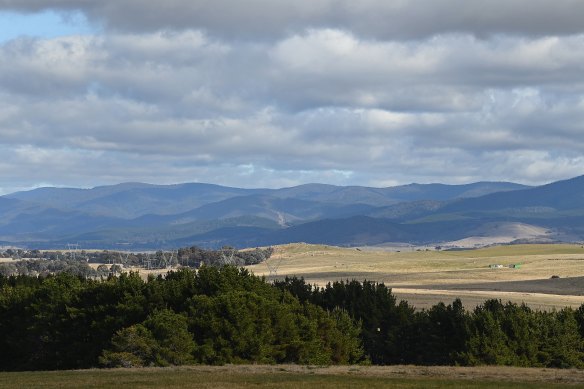
The site of the proposed Wallaroo solar farm beyond the trees is close to existing transmission lines that can carry the power to Canberra.Credit: Kate Geraghty
Many of the 570-odd community members – farmers, vineyard owners, commuters to Canberra and retirees – have solar panels on the roofs of their own homes or farm sheds, and some have a biodiesel generator as back-up.
But a massive solar farm, with about 182,000 photovoltaic modules, a substation and battery storage system spanning 165 hectares across two properties in Wallaroo, is a different proposition.
The project, which could power about 48,000 homes mostly in Canberra, is deemed state significant, and is supported by the NSW Department of Planning, Housing and Infrastructure.
Community member Adam Gresham told the meeting his main concern was the number of trucks travelling on the narrow country roads each day during construction and beyond.
He said there were 56 children, including his own – aged 16, 12 and 10 – who catch the school bus from the end of their driveways or across the road.
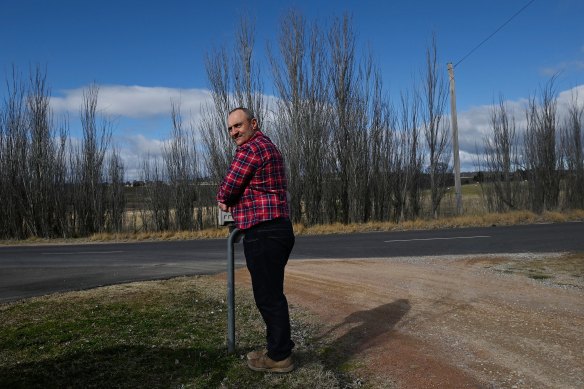
Firefighter and Wallaroo resident Adam Gresham standing at the end of his driveway, across the road from where the school bus stops in the afternoon.Credit: Kate Geraghty
“The verge is quite small and to think that people would allow multiple trucks to come through that area daily, and not think that is a risk, is quite scary for us,” he said, speaking to The Sydney Morning Herald after his presentation.
His wife Christy added that they were “not wealthy people”, and with a “monster mortgage”, they would be unable to move if prices dropped.
Gresham, an ACT firefighter for more than 20 years, is also concerned about the fire risk both in Wallaroo and on the outskirts of Canberra since the area is prone to bushfires and battery storage systems can be volatile.
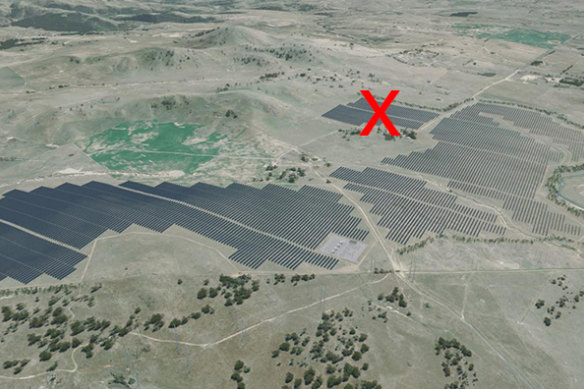
The original scale of the proposed Wallaroo Solar Farm and the area that was removed as marked by an X.
“To have something within hundreds of metres of residential properties and the toxins that will be created if something goes wrong, that will be carried through smoke to these residents is a major concern,” he said.
At the Murrumbateman Community Hall about 20 minutes from Wallaroo, the public meeting stretched over four hours, with a break for lunch. Twenty-five residents spoke against the project, raising issues about the impact on views, tourism, traffic and road safety, and fire risk.
Only the development manager for the project, Ben Cranston, spoke in favour. He said the project would deliver $1.6 million for community projects over 30 years, employ 150-200 people during construction, and four to five during the operational phase.
“If the project is approved, we will remove approximately 215,000 tonnes of greenhouse gases from the atmosphere [annually],” he said.
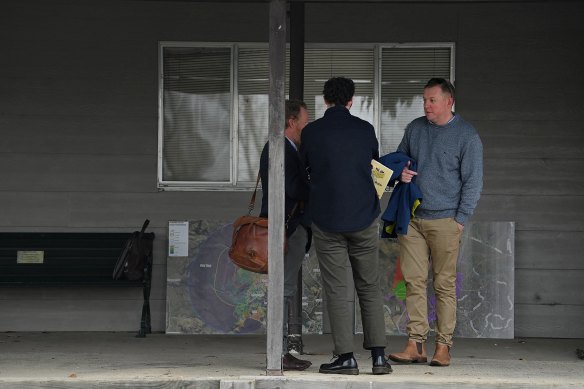
Ben Cranston (right), the development manager for the proposed Wallaroo Solar Farm, arrives at the public meeting.Credit: Kate Geraghty
Cranston said the project had been amended in the past week to reduce the footprint, as well as previous concessions to add landscaping, reduce glare, and control traffic.
Community member Ben Faulks told the Herald the landowners would make money, but the rest of the community would pay the price in lost amenity and lower property values.
“This is a transfer of wealth from the residents of Wallaroo to one or two landowners,” Faulks said.
Faulks said he supported renewables, but argued the project location was driven by the proponents rather than a planning decision about where a solar farm should be sited.
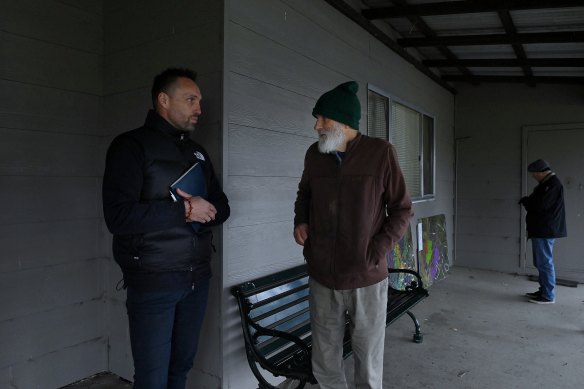
Wallaroo resident Ben Faulks (left) talking to a neighbour outside the public meeting in Murrumbateman.Credit: Kate Geraghty
Real estate agent Mark Johnstone, a resident of 23 years, told the meeting he expected a 20 per cent drop in property values from the loss of scenic beauty.
“I support renewables but not reckless renewables,” Johnstone said. “This is not the right location.”
Community member Andrew Cunich told the meeting he bought his property in 2020, paying a premium for the view, and building an outdoor lifestyle around it.
“Imagine if you bought yourself a brand new telly and somebody came up with a black texta and just went right across the centre of it and said ‘enjoy your TV’,” Cunich said.
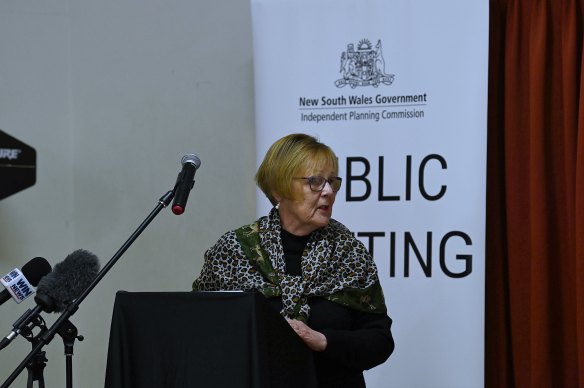
Canberra resident Marilyn Gendek said the city had been “invisible” to those assessing community impacts of the proposed solar farm.Credit: Kate Geraghty
The area is popular with cyclists and contains several vineyards, with signage on the Hume Highway, Federal Highway and Barton Highway promoting the wineries.
Prominent winemaker Nick O’Leary told the Herald he feared tourism would be diminished.
“If I went out to a winery from Canberra or Sydney, the last thing I’d want to see is a big solar factory on the way out to enjoy a nice lunch at a local winery,” O’Leary said.
Marilyn Gendek said thousands of homes in Canberra were also affected, but the NSW-ACT border meant “the city of Canberra is treated as invisible”.
Ramila Chanisheff from the Australian Uyghur Tangritagh Women’s Association called on the proponents to avoid buying panels built with slave labour.
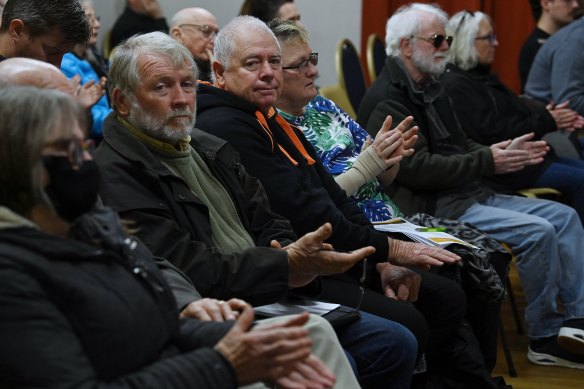
Members of the public attend a public meeting about the Wallaroo Solar Farm proposal, held by the Independent Planning Commission.Credit: Kate Geraghty
Get to the heart of what’s happening with climate change and the environment. Sign up for our fortnightly Environment newsletter.